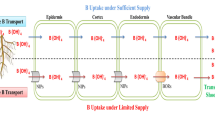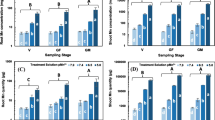Abstract
Gallium (Ga) is an emerging chemical pollutant chiefly associated with high-tech industries. Boron (B) alleviates the negative effects of toxic elements on plant growth. Thereby, the effects of B fertilization on Ga toxicity in rice seedlings was studied to clarify the role of iron plaque in the distribution of Ga, Fe, and B in Ga-treated rice seedlings in the presence or absence of B. Gallium exposure significantly reduced the biomass of rice seedlings. Boron deficiency induced a significant change in the distribution of B in Ga-treated rice seedlings compared with “Ga+B” treatments. Accumulation of Ga in roots, dithionite-citrate-bicarbonate (DCB) extracts, and shoots showed a dose-dependent manner from both +B and –B rice seedlings. Boron nutrition levels affect the distribution of Fe in roots, DCB extracts, and shoots, in which DCB-extractable Fe was significantly decreased from “Ga-B” treatments compared with “Ga+B” treatments. Root activity was significantly decreased in both Ga-exposed rice seedlings; however, B-deficient seedlings showed a severe reduction than +B rice seedlings. These results reveal that Fe plaque might be a temporary sink for B accumulation when plants are grown with proper B, wherein the re-utilization of DCB-extractable B stored in Fe plaque is mandatory for plant growth under B deficiency. Correlation analysis revealed that B deficiency decreased the root activity of Ga-exposed rice seedlings by reducing DCB-extractable Fe and increasing DCB-extractable Ga in Fe plaque. This study enhances our understanding of how B nutritional levels affect Ga toxicity in rice plants.






Similar content being viewed by others
References
Aquea F, Federici F, Moscoso C, Vega A, Jullian P, Haseloff J, Arce-Johnson P (2012) A molecular framework for the inhibition of Arabidopsis root growth in response to boron toxicity. Plant Cell Environ 35:719–734
Brdar-Jokanović M (2020) Boron toxicity and deficiency in agricultural plants. Int J Mol Sci 21:1424
Chang HF, Wang SL, Yeh KC (2017) Effect of gallium exposure in Arabidopsis thaliana is similar to aluminum stress. Environ Sci Technol 51:1241–1248
Dong YZ, Zu KZ, Cui XY, Ji P, Chen ZY, Li DY, Zhang ZA (2015) Changes of root activity and its correlation with plant biomass of soybean cultivars released in different years. Plant Physiol J 51:345–353
Fan J, Xia X, Hu Z, Ziadi N, Liu C (2013) Excessive sulfur supply reduces arsenic accumulation in brown rice. Plant Soil Environ 59:169–174
Hu Y, Huang YZ, Liu YX (2014) Influence of iron plaque on chromium accumulation and translocation in three rice (Oryza sativa L.) cultivars grown in solution culture. Chem Ecol 30:29–38
Jain R, Fan S, Kaden P, Tsushima S, Foerstendorf H, Barthen R, Pollmann K (2019) Recovery of gallium from wafer fabrication industry wastewaters by Desferrioxamine B and E using reversed-phase chromatography approach. Wat Res 158:203–212
Jensen H, Gaw S, Lehto NJ, Hassall L, Robinson BH (2018) The mobility and plant uptake of gallium and indium, two emerging contaminants associated with electronic waste and other sources. Chemosphere 209:675–684
Khan N, Seshadri B, Bolan N, Saint CP, Kirkham MB, Chowdhury S, Yamaguchi N, Lee DY, Li G, Kunhikrishnan A, Qi F, Karunanithi R, Qiu R, Zhu YG, Syu CH (2016) Root iron plaque on wetland plants as a dynamic pool of nutrients and contaminants. Adv Agron 138:1–96
Kopittke PM, McKenna BA, Blamey FPC, Wehr JB, Menzies NW (2009) Metal-induced cell rupture in elongating roots is associated with metal ion binding strengths. Plant Soil 322:303–315
Li J, Cao X, Jia X, Liu L, Cao H, Qin W, Li M (2021) Iron deficiency leads to chlorosis through impacting chlorophyll synthesis and nitrogen metabolism in Areca catechu L. Front Plant Sci 12:710093
Li Y, Zhao J, Zhang B, Zhang B, Liu Y, Xu H, Li YF, Li B, Gao Y, Chai Z (2016) The influence of iron plaque on the absorption, translocation and transformation of mercury in rice (Oryza sativa L.) seedlings exposed to different mercury species. Plant Soil 398:87–97
Liu JG, Leng XM, Wang MX, Zhu ZQ, Dai QH (2011) Iron plaque formation on roots of different rice cultivars and the relation with lead uptake. Ecotoxicol. Environ. Saf 74:1304–1309
Liu WJ, Zhu YG, Smith FA, Smith SE (2004) Do phosphorus nutrition and iron plaque alter arsenate (As) uptake by rice seedlings in hydroponic culture? New Phytol 162:481–488
Lopez-Lefebre LR, Rivero RM, Garcia PC, Sanchez E, Ruiz JM, Romero L (2002) Boron effect on mineral nutrients of tobacco. J Plant Nutr 25:509–522
Lu K, Yan L, Riza M, Babar S, Hou J, Zhang Y, Jiang C (2023) Exogenous boron alleviates salt stress in cotton by maintaining cell wall structure and ion homeostasis. Plant Physiol Biochem 201:107858
Pan X, Ullah A, Feng YX, Tian P, Yu XZ (2023) Proline-mediated activation of glyoxalase II improve methylglyoxal detoxification in Oryza sativa L. under chromium injury: Clarification via vector analysis of enzymatic activities and gene expression. Plant Physiol Biochem 201:107867
Peng JS, Zhang BC, Chen H, Wang MQ, Wang YT, Li HM et al. (2021) Galactosylation of rhamnogalacturonan-II for cell wall pectin biosynthesis is critical for root apoplastic iron reallocation in Arabidopsis. Mol Plant 14:1640–1651
Su JY, Syu CH, Lee DY (2018) Growth inhibition of rice (Oryza sativa L.) seedlings in Ga-and In-contaminated acidic soils is respectively caused by Al and Al+In toxicity. J Hazard Mater 344:274–282
Sun L, Zheng C, Yang J, Peng C, Xu C, Wang Y, Feng J, Shi J (2016) Impact of sulfur (S) fertilization in paddy soils on copper (Cu) accumulation in rice (Oryza sativa L.) plants under flooding conditions. Biol Fertil Soils 52:31–39
Syu CH, Chen PW, Huang CC, Lee DY (2020) Accumulation of gallium (Ga) and indium (In) in rice grains in Ga-and In-contaminated paddy soils. Environ Pollut 261:114189
Syu CH, Chien PH, Huang CC, Jiang PY, Juang KW, Lee DY (2017) The growth and uptake of Ga and In of rice (Oryza sative L.) seedlings as affected by Ga and In concentrations in hydroponic cultures. Ecotoxicol Environ Saf 135:32–39
US geological survey (2022). https://pubs.usgs.gov/periodicals/mcs2022/.
Yu XZ, Feng XH, Feng YX (2015) Phytotoxicity and transport of gallium (Ga) in rice seedlings for 2-day of exposure. Bull Environ Contam Toxicol 95:122–125
Yu XZ, Lu MR, Zhang XH (2017) The role of iron plaque in transport and distribution of chromium by rice seedlings. Cereal Res Commun 45:598–609
Yuan Y, Hao W, Mu W, Wang Z, Chen X, Liu Q et al. (2021) Toward emerging gallium oxide semiconductors: A roadmap. Fundam Res 1:697–716
Zandi P, Yang J, Xia X, Tian Y, Li Q, Mozdzen K, Barabasz-Krasny B, Wang Y (2020) Do sulfur and rhizoplane iron plaque affect chromium uptake by rice (Oryza sativa L.) seedlings in solution culture? J Harzard Mater 388:121803
Zandi P, Yang J, Darma A, Bloem E, Xia X, Wang Y, Li Q, Schnug E (2023) Iron plaque formation, characteristics, and its role as a barrier and/or facilitator to heavy metal uptake in hydrophyte rice (Oryza sativa L.). Environ Geochem Health 45:525–559
Zhang DC, Ullah A, Tian P, Yu XZ (2023) Response to gallium (Ga) exposure and its distribution in rice plants. Environ Sci Pollut Res 30:121908–121914
Zhou XB, Shi Wm, Zhang LH (2007) Iron plaque outside roots affects selenite uptake by rice seedlings (Oryza Sativa L.) grown in solution culture. Plant Soil 290:17–28
Author contributions
Investigation, and data analysis, W-LR; Investigation, data analysis, and software, C-ZL; Writing original draft preparation, AU; Conceptualization, methodology, supervision, writing, reviewing, Editing, and funding acquisition, X-ZY. All of the authors contributed to the final review of the manuscript.
Funding
This work is financially supported by the National Natural Science Foundation of China (No.42277361).
Author information
Authors and Affiliations
Corresponding author
Ethics declarations
Conflict of interest
The authors declare no competing interests.
Additional information
Publisher’s note Springer Nature remains neutral with regard to jurisdictional claims in published maps and institutional affiliations.
Supplementary Information
Rights and permissions
Springer Nature or its licensor (e.g. a society or other partner) holds exclusive rights to this article under a publishing agreement with the author(s) or other rightsholder(s); author self-archiving of the accepted manuscript version of this article is solely governed by the terms of such publishing agreement and applicable law.
About this article
Cite this article
Ren, WL., Li, CZ., Ullah, A. et al. Boron deficiency decreased the root activity of Ga-exposed rice seedlings by reducing iron accumulation and increasing Ga in iron plaque. Ecotoxicology 33, 142–150 (2024). https://doi.org/10.1007/s10646-024-02731-5
Accepted:
Published:
Issue Date:
DOI: https://doi.org/10.1007/s10646-024-02731-5




